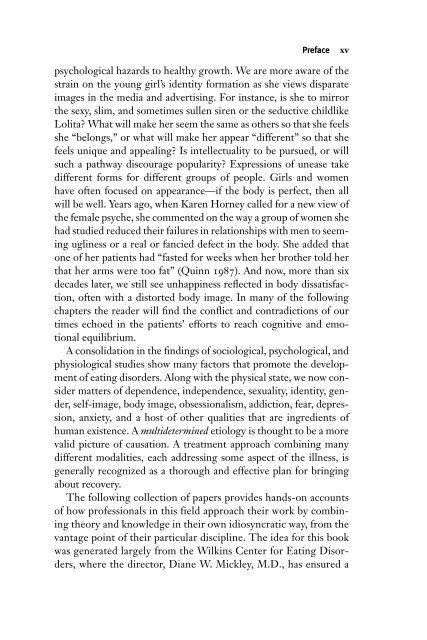Eating Disorders - fieldi
Eating Disorders - fieldi
Eating Disorders - fieldi
Create successful ePaper yourself
Turn your PDF publications into a flip-book with our unique Google optimized e-Paper software.
Preface xv<br />
psychological hazards to healthy growth. We are more aware of the<br />
strain on the young girl’s identity formation as she views disparate<br />
images in the media and advertising. For instance, is she to mirror<br />
the sexy, slim, and sometimes sullen siren or the seductive childlike<br />
Lolita? What will make her seem the same as others so that she feels<br />
she “belongs,” or what will make her appear “different” so that she<br />
feels unique and appealing? Is intellectuality to be pursued, or will<br />
such a pathway discourage popularity? Expressions of unease take<br />
different forms for different groups of people. Girls and women<br />
have often focused on appearance—if the body is perfect, then all<br />
will be well. Years ago, when Karen Horney called for a new view of<br />
the female psyche, she commented on the way a group of women she<br />
had studied reduced their failures in relationships with men to seeming<br />
ugliness or a real or fancied defect in the body. She added that<br />
one of her patients had “fasted for weeks when her brother told her<br />
that her arms were too fat” (Quinn 1987). And now, more than six<br />
decades later, we still see unhappiness reflected in body dissatisfaction,<br />
often with a distorted body image. In many of the following<br />
chapters the reader will find the conflict and contradictions of our<br />
times echoed in the patients’ efforts to reach cognitive and emotional<br />
equilibrium.<br />
A consolidation in the findings of sociological, psychological, and<br />
physiological studies show many factors that promote the development<br />
of eating disorders. Along with the physical state, we now consider<br />
matters of dependence, independence, sexuality, identity, gender,<br />
self-image, body image, obsessionalism, addiction, fear, depression,<br />
anxiety, and a host of other qualities that are ingredients of<br />
human existence. A multidetermined etiology is thought to be a more<br />
valid picture of causation. A treatment approach combining many<br />
different modalities, each addressing some aspect of the illness, is<br />
generally recognized as a thorough and effective plan for bringing<br />
about recovery.<br />
The following collection of papers provides hands-on accounts<br />
of how professionals in this field approach their work by combining<br />
theory and knowledge in their own idiosyncratic way, from the<br />
vantage point of their particular discipline. The idea for this book<br />
was generated largely from the Wilkins Center for <strong>Eating</strong> <strong>Disorders</strong>,<br />
where the director, Diane W. Mickley, M.D., has ensured a









